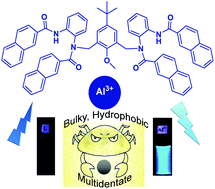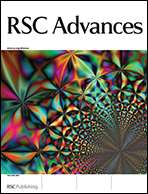The importance of water exclusion: an effective design strategy for detection of Al3+ ions with high sensitivity†‡
Abstract
Incorporation of hydrophobic units in a chemosensor for detection of ions in aqueous media seems counterintuitive. However, this work demonstrates that a sensor designed by incorporating local hydrophobicity around a multidentate receptor to achieve desolvation of a strongly hydrated Al3+ ion results in efficient binding of the ion, and consequently elicits a strong fluorescence response. The simultaneous detection of Fe3+ in water was suppressed by using the differential behaviour of the sensor in a methanol–water mixture. The sensor shows a remarkable detection limit of 57 nM for Al3+ which is among one of the lowest reported so far.


 Please wait while we load your content...
Please wait while we load your content...